Trend-Setting High-Rise Offers No Parking
10-floor, 72-unit apartment complex proposed for Downtown includes no parking spots.
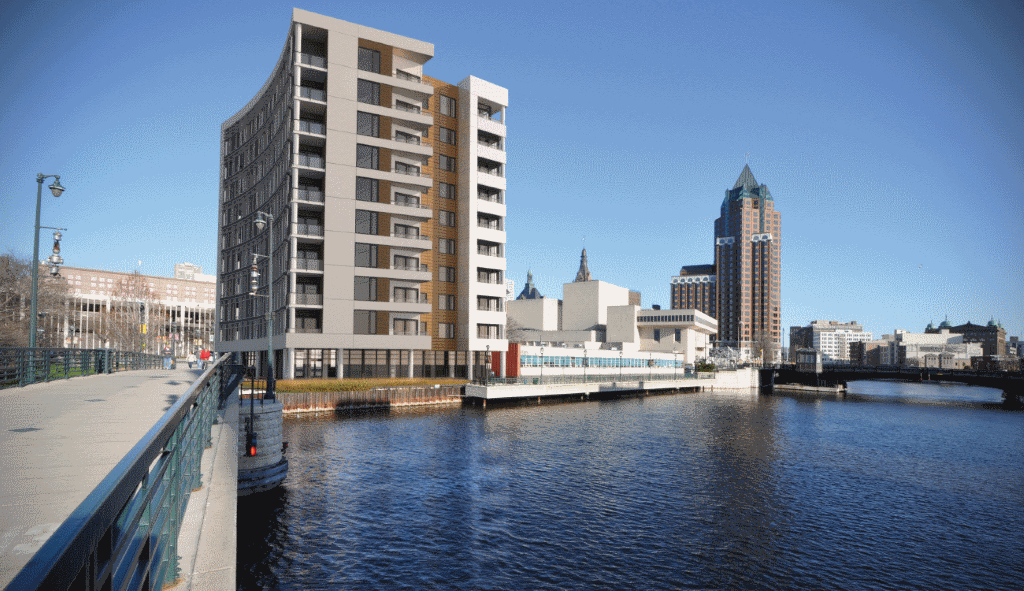
Proposal by Klein Development Inc. for 1027 N. Edison St. Rendering by Korb + Associates Architects.
Late last week news broke that the City of Milwaukee had selected Klein Development Inc.’s proposal to build a $15 million, 10-story apartment building at 1027 N. Edison St., next to the Highland Ave. pedestrian bridge. It was selected from four proposals the city had received in response to a request for proposals (RFP) it issued to develop a portion of the 19,985-square-foot, city-owned lot. The RFP required a building of six to ten stories with all structured parking to be located below ground.
This wasn’t the first RFP issued for this site by the city. Back in late 2007 Russ Davis responded to a city RFP for this location with a proposal to build an eight-story, environmentally friendly, mixed-use building, called Edison Green, but that project never moved forward.
In a Business Journal story about the current proposal Sean Ryan laid out the details of the Klein’s proposal. “Its proposal includes 72 high-end apartments and 4,500 square feet of ground floor space for a restaurant,” wrote Ryan.
He noted the ground-floor restaurant is to be a “higher-end brew pub” with patio seating near the Riverwalk, and that the proposal isn’t that far from where the Milwaukee Bucks plan to build their new arena. The apartments would rent for about $1,600 to $1,800 a month and the plans called for 20 two-bedroom apartments, 45 one-bedroom apartments and a number of studios.
Klein would purchase the lot from the city for $840,000, which was the asking price the city was looking for, and if Klein could obtain all the needed approvals it would start construction in spring 2016 and finish the building in spring 2017.
Tom Daykin had a story for the Milwaukee Journal Sentinel on the project as well.
But something was missing from both stories: How much parking will this building have?
The answer: None.
That’s how you can build a 10-story, 72-unit apartment building for $15 million. At an average cost of $20,000 per above ground parking spot (if allowed by the RFP), with one parking spot per bedroom (a number that is often cited as the bare minimum), the building would have incurred an additional cost of $1.84 million to build, and undoubtedly prominently feature, a garish parking plinth with multiple stories dedicated just to parking, and thereby eliminating the ground-floor, “higher-end brew pub.” And if they had attempted to build all this parking below ground, it could have easily added $3.68 million, if not more to the cost of the project.
With no parking the average cost per unit will be $208,333 (not taking into account the restaurant space), but with above ground parking that would have risen to $233,888 a unit. With underground parking the average per-unit cost would be at least $259,444, which in turn would push the apartment rental rates higher than the $1,600 to $1,800 a month. And to accommodate parking, the project would have likely eliminated the brewpub space, while adding garage doors, ramps, and curb cuts. Not unlike the neighboring, yet misplaced, town homes located along N. Edison St.
Project architect Jason Korb, Principal Architect at Korb + Associates Architects, pointed out to me that the Marcus Center for the Performing Arts’ parking garage is located just across the street from this project, which is intended as a “walk to work building.”
To build a new apartment building without parking is generally reserved for cities with great walkability and fixed-rail transit service such as Portland, Seattle, and Boston. In fact, according to a story by Angie Schmitt for Streetsblog, in 2012 some 40 new apartment buildings opened in Portland and about half contained no parking.
Might this be a start of a new, urban trend in Milwaukee? Here’s hoping.
Renderings and Plans
High-Rise on Streetcar Line
Colleague Jeramey Jannene first broke the news that Mandel Group, Inc. was working on plans to build a 240-unit, 20+ story high-end apartment tower on lake bluff property it owns at N. Prospect and E. Ogden avenues back in August 2013. And in May of this year, Michael Horne reported that Barry Mandel, CEO of Mandel Group, indicated the company intended to break ground on multiple projects within the City of Milwaukee this year. Indications are that this high-rise could be one of them. The location of this high-rise sits at the end of the The Milwaukee Streetcar’s Phase I route.
Here’s what Mandel Group’s Chief Operating Officer Robert Monnat had to say about the streetcar project in a recent Milwaukee Streetcar newsletter:
“We think our future residents will love the opportunity to board the streetcar at their front door and easily travel throughout the downtown for shopping, work, restaurants, theater, attractions and as an easy link to the Intermodal station,” said Monnat. “We’re seeing a gradual but consistent reduction in the number of cars our downtown residents own, which can be attributed to their desire to use alternate modes of transportation. Having the downtown streetcar operational will enhance this trend and simply make it more fun to get around downtown Milwaukee to everyday destinations.”
In Other News
- According to the U.S. Census Bureau the Homeownership rate dropped from 64.7 percent to 63.4 percent from the second quarter 2014 to the second quarter 2015.
- Oh yeah, the Assembly will vote on the funding for the new Milwaukee Bucks arena today. What’s your prediction?
And in case you missed it, we featured the Walker’s Landing apartment project in last week’s Friday Photos.
Plats and Parcels
-
New Third Ward Tower Will Be Milwaukee’s Priciest
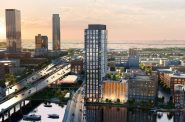 Mar 3rd, 2024 by Jeramey Jannene
Mar 3rd, 2024 by Jeramey Jannene
-
New Corporate Headquarters, 130 Jobs For Downtown
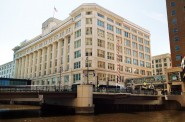 Feb 25th, 2024 by Jeramey Jannene
Feb 25th, 2024 by Jeramey Jannene
-
A Four-Way Preservation Fight Over Wisconsin Avenue
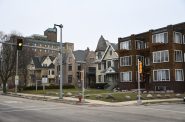 Feb 18th, 2024 by Jeramey Jannene
Feb 18th, 2024 by Jeramey Jannene


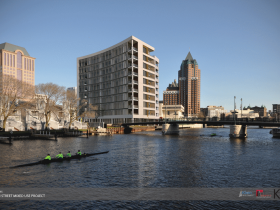
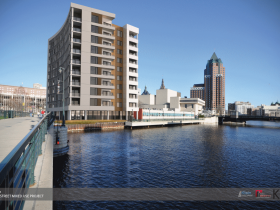
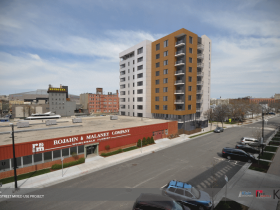
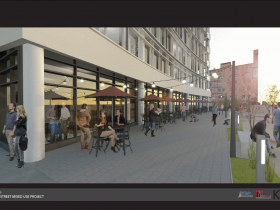
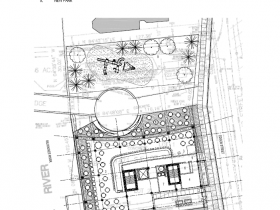
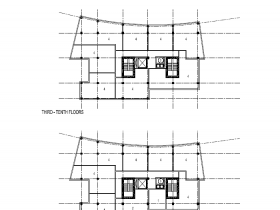




















Why do you say the townhomes are misplaced?
Mjones, the neighboring town homes are single story single family units that were put in during the 80’s and make poor use of prime real estate along the river. Almost all other residential developments close to the waterfront have called for a much higher density.
@Mjones First, I am aware they were built during a time when the city was happy to see any development so the design rules were likely very lax. But from a design perspective these are terribly suburban. From a pedestrian’s viewpoint they are a series of snout-nosed garages, not homes. They provide little to no eyes on the street. These fit perfectly on a suburban cul-de-sac. And all the while cut off public access to the river.
And what Chris said.
Give me some color! Boy am I tired of the color palette that local architects are using these days. So bland and so boring.
I’m interested in seeing how the no parking situation works out in the long run. Nearly everyone I know who doesn’t have a car does it for financial reasons (and thus, won’t be living in $1600-$1800) apartments. Obviously, “everyone I know” isn’t representative of the entire population, but it would be interesting to know how many of the units end up filled by those who do not own cars vs. those who have to find parking elsewhere.
Can someone comment on how this fits with parking requirements in the city? I was under the impression that projects were required to provide a certain number of parking spaces per unit. Is that only in certain neighborhoods or can exceptions be made? I can’t imagine a project like this ever gaining ground on the Eastside or Bay View because any neighborhood meeting would be overwhelmed by people complaining about new residents making it more difficult to find street parking.
The parking garage across the street offers a very reasonable $90 per month rate for parking. As long as that exists, I suppose the need for parking in the building isn’t so great.
The city is relaxing the parking requirements. The hope is that the streetcar and other transit improvements such as Uber, Lyft, Bublr, etc, will get people out of their cars. At least one car per couple rather than two. Parking and their incredible costs are killing many developments. The parking costs referenced in the article are very telling. Furthermore, Milwaukee has an abundance of parking options at any of our many underutilized parking structures. Maybe people can rent spaces at night from some of these structures? In the immediate vicinity of the proposed development there is the 1000 Water structure that is mostly empty, Marcus Center structure, 735 right down the river walk and others. I think a new day is dawning, but we need to ensure that transit alternatives are available, the streets are walkable and biking is safe.
This project is an important step forward for the City. There are so many reasons to support the notion of no parking, or shared parking. Great cities promote walkability, bike-ability, and multimodal transit first.
My only gripe with this project is the public realm that surrounds the building. When not having to spend millions on parking, it would be nice to see a bigger investment in a truly alive ground floor… The ground floor as designed looks like an hermetically sealed corporate office headquarters… You’re either in or out in this thing. How about actually connecting to the outdoors with operable windows and doors, creating high quality, well-defined outdoor plaza space, etc?… Perhaps that will come as a tenant is announced and design further developed… Look no further than the Ale Asylum across the river to see what fixed windows, dark glass and little connection to the outdoors does for you.
Good looking project.. .lets roll!
@Devin There has essentially been no downtown parking requirement for most downtown zoning districts since 1986.
Here is a good discussion on how parking (or its lack) influences rent levels in urban apartment buildings. It’s part of a very good series on parking, which is a major—but usually unnoticed—automobile subsidy.
http://daily.sightline.org/2013/08/22/apartment-blockers/
Minimum parking requirements for new construction raise rents and cause renters without cars to subsidize those with cars. We should let the developers decide how many spaces they need to market their buildings.
I really only have two things to (legitimately, no sarcasm) question:
1) Why does every new building/proposed building look almost identical? Is it a trend to have the same color scheme, same use of mixed materials, same type of façade? At this rate MKE is going to start looking like a communist bloc….
2) I get why it would be great if MKE reduced the number of cars but the truth is that many of us work outside the city where it is not feasible to use public transportation to get to work. What are those people supposed to do? At rent prices of $1600 – $1800 per month, adding $90 – $100 for a parking garage across the street or down the street makes a building like this downright unappealing. And Milwaukee does not have enough jobs in a wide enough range of fields to support “everyone who lives in the city works in the city”.
@Crystal B I’d say to 1 that simply a personal preference but the building does what urban buildings are supposed to do (okay the first floor could be more opened up).
But as far as 2 rent in a different building?
We should not encourage nor discourage parking to be built in new construction. Let the Developers decide. If there is sparse parking, developers may believe it advantageous to build parking even with high rents or costs… if there’s a lot of parking, they may decide it’s not needed and can build developments that are lower cost. It’s important to keep it organic though.
Too often I see people preaching that we should making driving or parking more difficult. That will create an artificial situation that is trying to emulate places that draw pedestrians for other reasons. You must build a streetscape or neighborhood that attracts people and everything else will balance out eventually.
Planning accessible transportation is good planning… but purposely discouraging auto traffic to try to emulate other neighborhoods in cities with parking issues does not guarantee the outcome you’re looking for.
After looking at the floor plans, the building looks like a poor design (although it’s really not my concern).
First there is just one elevator in a 72-unit,10-story building! Elevators fail and can be out of service for hours. Sometimes they are replaced and can be out for a week or more. They are also unavailable when somebody is moving in or out (or when a large piece of furniture is delivered).
Second, the service entrance doesn’t seem to connect to the single elevator at all. This means that all movers and furniture deliveries go through the lobby which looks awfully narrow. When the elevator and lobby are commandeered by movers, the stairs aren’t an option (even if you can climb 9 flights), since both stairways use the same narrow lobby.
Third, where is the entry for the restaurant? If it’s on Edison, it’s right next to the residence entrance, which will be blocked by movers a few times each month.
Fourth, the fire exits seem poor. There are two stairways, both of which exit through the same door—the same one used for the elevator. If there is a fire (or other problem—like something falling from the exterior) near that door, there is no exit from the building.
Fifth, the restaurant’s kitchen appears to adjoin the trash room, where garbage sits for days waiting for pickup. This isn’t a good idea.
One other note… Google Maps shows a “No Overnight Parking” sign on the garage across the street which would seem to make it unusable for tenants.
@Tom D Design stuff aside it is my understanding you can get a monthly pass at the PAC for $90 bucks. I imagine the signs means you can’t be a short term parker and leave your car overnight.
If this building does not supply the amenities one desires, then one can look to rent elsewhere. Or buy elsewhere, if it were an owner-occupied building. Parking should not be required at residential developments. Developers should be able to choose whether to include it in a building and residents are free to choose whether or not to live there. Requiring parking increases housing costs for all, whether or not one utilizes that parking, and effectively subsidizes the cost of auto ownership. It is an absurd situation where far too many of us expect parking to be free (or apparently “free”).
@Dave Reid my point in #2 in my above comment was more to address the final line in the article, “Might this be a start of a new, urban trend in Milwaukee? Here’s hoping”. Currently it is not an issue to look for a building, old or new, with parking amenities. However, if it becomes a long-term trend for new buildings to be built without parking eventually those who have no choice but to own a car will be prevented from enjoying living in new development in the city (unless they want to pony up even more cash for a garage on top of what are already quite high market-rate rents).
@Crystal B Downtown is overparked. There are parking garages literally everywhere (which btw are essentially never full), so instead of building more parking, shared parking is an ideal solution. Apartments all over the East Side have 0 parking, and boy does it work. The trend would be good because building garages limits density, walkability, taxbase, and more.
Dave Reid, it works on the east side, but has it’s drawbacks too. When I lived there, I rented covered parking because I didn’t work downtown and needed my car (ok, I also wanted it too). The only parking readily available had a 4 month waiting list the whole time I lived there. My roommate eventually moved out of the East side because of the parking challenges and friends from outside the east side wouldn’t visit during peak parking times. As much as it worked, it also hurts the neighborhood as well.
I still say it’s up to developers to decide to create parking, but we also can’t point to the east side as a perfect scenario. Especially when some people fight it when developers DO think it’s an asset to add parking (ahem, Downer parking garage anyone?)
Dave Reid,
From the PAC website:
As a monthly parker you are given a key card that gives you access to the structure at any time, however overnight parking is not permitted.
@Tom D Well that is interesting. But not un-fixable. For example, for years my building leased a block of spots in an existing garage, that then apartment tenants could rent. I’d imagine a similar deal could be worked out.
And if not, then there is 1000 N. Water which does have monthly permits, and years ago I left my car there for weeks on end.
In my eyes this ten story development is the appetizer and the potential of the floral shop next door is the entrée. Turn the floral into a mixed use high rise development with parking for both lots as well as a first floor grocery store and now we are talking!
Too bad the River Tower never got off the ground. That was a sweet building. This place is out of my price range by double, so it’s moot to me. It’s an okay design. I would like to see the river downtown have some taller buildings here and there.
As for parking, I went seven years of relying on public transportation between Kenosha and Deerfield IL, which finally forced me to move a little closer all because I couldn’t afford a decent car for a long time. Now I have a car again and it is bliss! I will never go without it again. Public transportation is so inconvenient especially if you have to go multi-modal, taking a train and a bus to get somewhere for example. There is so much wasted time waiting for the train, waiting for the bus, especially if the train is late and you miss your bus.
I was really hoping to live downtown in Milwaukee when I finally get back up there, but I’ll be damned if I’m going to have to park my car in a place across a busy intersection from my building, especially for $100 or more a month. So much for that.
So many people here think this won’t work because they don’t want to live here. Did you ever think there are other people… oh, say, at least 72 that would want to live here out of the nearly 2,000,000 in the entire metro area?
Boggles the small minds I reckon. The market is saying no parking needs to be built here… let the market work. What’s the worst that will happen? Seriously.
A few years ago I was living in a downtown apartment without any parking, in an area where overnight on street parking was banned and yet I was always able to find a convenient place to park my car. Most days I would park in a municipal parking lot across the street which was only metered during the day. Since I worked M-F 9-5, I was almost always out of the lot when the meters were active. The only times I ever paid for parking was when I had a day off, and then I would either just leave my car there and pay for a full day of parking, or I would park in the banks parking lot across(on weekends), or I would park a few blocks away where parking was cheaper. It was not a big issue to be renting an apartment without any parking spaces, because there is always parking nearby, and even if you occasionally have to pay for parking, it is probably cheaper than renting an apartment with a parking space. I think when I was living in the downtown apartment I was spending about $10-15 a month on parking meters, lots, etc. which is a ton less than if I had paid a monthly rate.
A couple of people have mentioned the cost of having to park at an offsite garage so I thought that I would mention that many (if not most/all) of the new developments charge extra for parking anyway. The primary inconvenience is having to park at an offsite, potentially unsecured lot, rather than cost. You would probably still be paying $75-$125 extra per month, on top of the regular rent, to have a spot in your building.
I agree that in most places the developer should have the option to include parking, as its an amenity rather than a necessity, though I don’t think the market has “decided” yet. The developers are saying that no parking needs to be built there. The market will decide once the project is completed and they are able to fill all of the units.